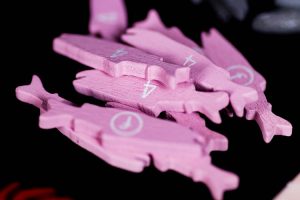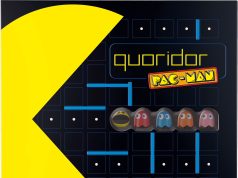 I’ve written reviews for most of the Tokyo series from Jordan Draper at this point. Generally speaking, the heavier, more-euro-like games are what get me excited about these releases. Not to say the more lighthearted games in the series aren’t interesting, I appreciate what they do, but it’s the idea of a big game in a small box that I really get into.
I’ve written reviews for most of the Tokyo series from Jordan Draper at this point. Generally speaking, the heavier, more-euro-like games are what get me excited about these releases. Not to say the more lighthearted games in the series aren’t interesting, I appreciate what they do, but it’s the idea of a big game in a small box that I really get into.
In the newest Tokyo series, that game is Tokyo Tsukiji Market. Players take on the role of a fishing company and will do their best impression of a captain from The Deadliest Catch trying to make their personal fortune.
Gameplay Overview:
Each game of Tokyo Tsukiji Market has a lot of variable setup. You’ll use a different number of fish markets and external markets based on the number of players. There are 9 different markets of each type and even with the game’s full complement of six players, you’ll use just about half of them.
After you’ve done the setup, players will take turns around the table taking two actions. Those actions can include:
- Fishing — Each ship takes its own fishing action. This can be to leave port, enter port, or to use a license to catch a fish if it isn’t currently in port. If a ship enters port with fish, you immediately price them at your harbor.
- Visit a Market – Visit a fish market to obtain a license or to sell fish. Or visit an external market to take its action.
- Purchase – Buy fish from any number of other players at the price they’ve set.

Generally, you’ll be trying to catch fish to sell. And then you’ll use that money to buy fish from other players. Fish are also worth “resources” which are essentially victory points in the game. So if you have plenty of money it may be best to hold onto them rather than sell them.
Each fish market is unique though, so let’s look at some examples:
- Mackerel — The most basic fish, which is always included. Worth one resource each or can be sold in pairs for 100¥. It is the only fish that you can sell your own of, generally you can only sell fish you’ve purchased from other players.
- Eel — Value increased each time a player catches an eel. But devalues by two each time one is sold.
- Spider Crab — Ships can only return to dock with spider crab if they have at least two. Doing so will trigger an auction. A spider crab is blindly pulled from a bag (with variable resource values) and auctioned off in a blind bid.
All of this continues until one player either has 5,000¥ or 50 value of resources. However, the game end isn’t triggered if you have the least of the “other thing”. So if you have 50 resources, but you have less yen than all other players, the game continues normally. Once it is over, resources are multiplied by 100 and converted to yen, and then whoever has the most money wins.

Game Experience:
Tokyo Tsukiji Market draws a lot of inspiration from Container, a game with more of an auction focus. While I like auction games, the economy in Container was a little too fragile for my tastes and the game could really be hurt by someone making a poor choice. Here we get euro game inspired guard rails to keep the game on track.
I really appreciate the variability the game provides. Each market works differently and the combinations you can create are near endless. The external markets provide other options—aquariums to sell your fish to, an option to sell boats back for money, etc… You can get a lot of different strategies from game to game as it’s a changing landscape every time.

And most of the playing of the game comes from making the most out of the market interactions. Since the conversion from resources to yen is unchanging, it’s generally pretty obvious what a fish is worth in terms of points. So you will rarely find a player willing to overpay for your catch of the day. But liquidity can be vital and even small gains of cash can be very beneficial. A lot of the fun here is trying to talk your fellow fishmongers to come over and buy your eels.
And if they don’t… the fish degrade on your turn. If they are already degraded? They rot and are discarded. Sometimes you’ll really have to price the fish to sell quickly.
Overall, there is lots of great room for strategy and trying new things. Maybe you should try to buy a bunch of ships and just catch all the mackerel you can? Or get the very expensive tuna license and hope to hit it big? Is it worth investing the barge so your ships can drop off without having to return to the dock?

My biggest gripe is that the game feels extremely slow, especially in the middle. You start with a bit of money and you will gleefully spend it at the beginning of the game. But so do all the other players. So they don’t have any money to buy your fish. And there are very few opportunities to inject money back into the economy. You get a small 100¥ bonus when you bring in two of the same fish in the same turn. That’s basically it unless you have some external markets that can give you more money as well.
So you’ll slog through a lot of turns in the middle of the game trying to just scrape together a couple of hundred yen here and there. Eventually, this can build off to some bigger turns toward the end, but it’s overall can give the game a weird pace, especially with slower players at the table.

Unfortunately, there are more than a couple of problems with the production itself though. The pieces are tiny. Like… impossibly small. Hard to manipulate. Also, some of the fish are very close in color. The red snapper and spider crab are nearly indistinguishable. The fish tokens themselves are obviously very different shapes, so that’s no problem. But all the fish have barrel markers that are the same shape.
Then there is the rulebook. Entire things are just missing. You start the game with one open dock and two other docks on your player board that are covered up. How do you unlock them? The rulebook doesn’t mention it. Anywhere. Overall the game’s BGG forum has 81 posts at the moment—49 of them in the rules section. Jordan is very responsive and there is a nice FAQ at this point, but it was a tough learn and you’ll need those other resources.
Final Thoughts:
Tokyo Tsukiji Market has a great amount of variability that just isn’t common in most euro games. I love the room it gives players to experiment with new ideas and combos and really explore possibilities. There isn’t really an overpowering strategy to find and if you happen to come across one you’ll have different markets to deal with the next time you play. If you can get through the middle of the game without slowing things down too much, it’s a blast.
But the issues with playability here are real and disappointing. I’m willing to forgive the tiny pieces—I did say I wanted a big game in a small box at the beginning—but the color palette and rulebook omissions are worse. Obviously, they aren’t long term issues but may make it hard to get Tokyo Tsukiji Market to the table initially.
Final Score: 3 Stars – A solid and unique game. Great theme and lots of options to explore on your turn. Dragged down a bit by a poor rulebook and a slow midgame.
 Hits:
Hits:
• So many different markets that can work together in interesting ways gives players a lot to explore.
• Player driven markets in a very tight economy allow for a lot of in-game banter.
Misses:
• Middle of the game can be slow when all players are broke.
• Rulebook omissions and components are basically the same colors.






















